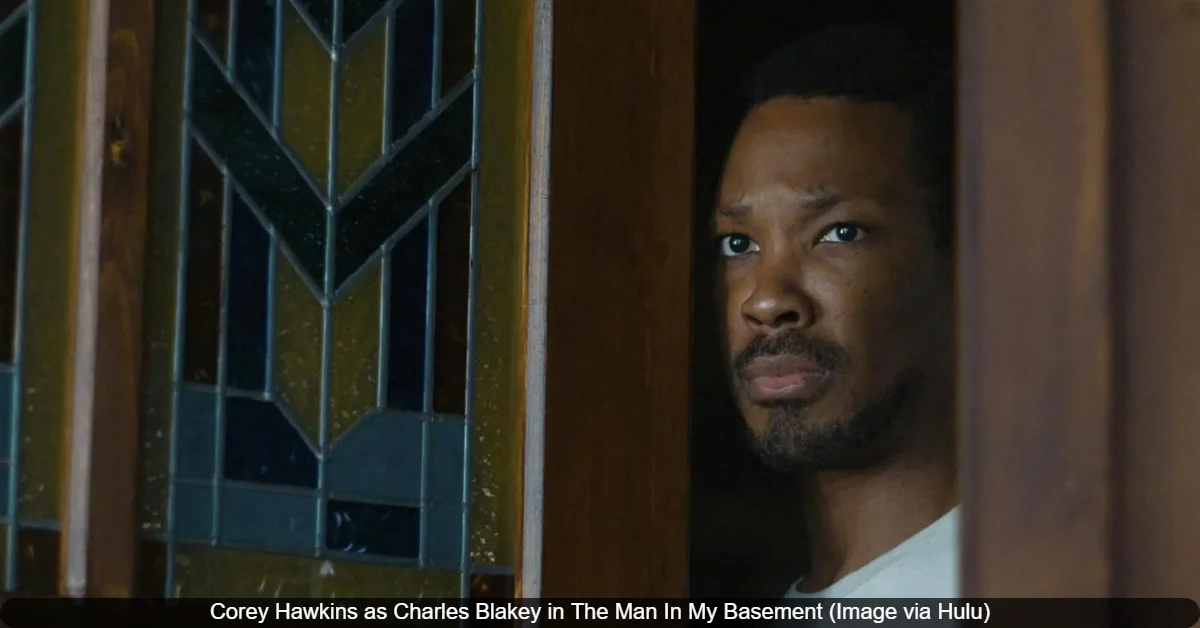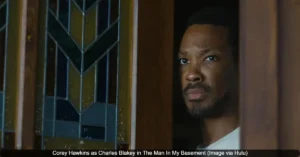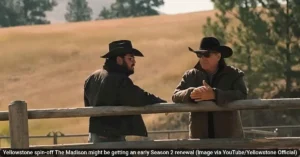The new thriller The Man in My Basement, starring Corey Hawkins and Willem Dafoe, has captivated audiences with its unsettling story of a struggling homeowner who agrees to let a mysterious stranger live in his basement for a large sum of money. While the premise feels like it could be ripped from horrifying real-life headlines, the film is not based on a true story. It is a fictional adaptation of Walter Mosley‘s 2004 novel of the same name, which uses its bizarre central relationship to explore profound themes of race, power, and historical guilt.
The film, which premiered at the 2025 Toronto International Film Festival and was released on September 12, 2025, follows Charles Blakey, a Black man in Sag Harbor on the brink of losing his family’s ancestral home. His life takes a strange turn when the enigmatic Anniston Bennet offers him $50,000 to rent his basement, only to then install himself in a cage and force Charles into the role of a jailer. Despite its realistic setting and psychological intensity, the narrative is entirely a work of fiction, serving as a complex allegory rather than a recounting of true events.
What Is ‘The Man in My Basement’ Based On?
The Man in My Basement is directly adapted from the 2004 novel by acclaimed author Walter Mosley, who also co-wrote the screenplay with director Nadia Latif. The story is a departure from Mosley’s famous detective fiction, instead offering a philosophical and psychological exploration of power dynamics. The novel and its film adaptation use their central premise to examine heavy themes, including the legacy of slavery, the commodification of history, and the complex relationship between guilt and punishment.
The core of the story is the unsettling arrangement between Charles Blakey and Anniston Bennet. As one review notes, their dynamic becomes “a rich ground for exploring themes of confinement, guilt, and redemption,” with a distinct racial component that the audience could guess from the start . Bennet, a wealthy white man, claims to be atoning for unspecified crimes against humanity by imprisoning himself, effectively making Charles, a Black man in financial distress, his jailer. This role reversal is intentional, creating a scenario that forces both characters—and the audience—to confront uncomfortable historical and social truths.
The Fritzl Case: A Disturbing Real-Life Parallel
While the film is fictional, its premise of a person held captive in a basement inevitably draws comparisons to one of the most notorious true crime cases in modern history: the Fritzl case in Austria. In 2008, it was discovered that Josef Fritzl had held his daughter, Elisabeth, captive in a concealed basement dungeon for 24 years. During her imprisonment, he repeatedly assaulted and raped her, resulting in the birth of seven children. One child died in infancy, and three were raised upstairs by Fritzl and his wife, who were presented to authorities as foster parents .
The parallels are superficial but striking. Both stories involve a basement used to imprison another human being, creating a hidden world of control and abuse. However, the motivations and outcomes are vastly different. Josef Fritzl was motivated by a desire for sexual slavery and control, a horrific real-world crime that shocked the world. In contrast, Anniston Bennet’s self-imprisonment in The Man in My Basement is a voluntary act, a symbolic gesture that he describes as penance for his past. The film uses this setup not to recreate a true crime, but to launch a metaphorical discussion about much larger concepts.
A Story of Metaphor, Not Fact
Director Nadia Latif and writer Walter Mosley have crafted a narrative that is deeply allegorical. The film has been described as “a metaphor for racism and capitalism, for exploitation and for the historically hidden violence built into the foundations of ownership” . The basement itself becomes a powerful symbol for the hidden, uncomfortable foundations upon which personal and national histories are built.
The discovery of valuable African masks and family heirlooms in Charles’s house further connects his personal financial struggle to the broader theme of reclaiming and understanding Black history. As Charles interacts with antiques dealer Narciss Gully (Anna Diop), he begins to uncover the cultural significance of his own heritage, a journey that runs parallel to his bizarre relationship with his tenant . This subplot reinforces that the film is primarily concerned with exploring ideological and historical conflicts rather than documenting a true story.
Critical Reception and Thematic Goals
Early reviews of the film have largely focused on its ambitious thematic goals and the strength of its lead performances, particularly the “spirited exchanges” between Corey Hawkins and Willem Dafoe . However, some critics noted that the film’s dense symbolism sometimes becomes overwhelming, with one review stating that the metaphor is “like a labyrinth in which characters and audience can get disoriented” . Another critique pointed out that the film feels “too hesitant to really dig into the fertile dirt provided by the text,” ultimately leaving its complex ideas not fully realized .
This reception underscores that the film’s primary aim is to provoke thought and discussion about its weighty themes. It is designed to be a “conversation starter more than a statement” , using its fictional and highly unusual scenario to ask difficult questions about guilt, race, and power. The final shot, which shows a character reading Frantz Fanon’s seminal postcolonial work The Wretched of the Earth, makes the film’s intellectual ambitions clear .
Conclusion: A Work of Philosophical Fiction
In summary, The Man in My Basement is not based on a true story. It is a work of fiction adapted from Walter Mosley’s novel, designed to use its gripping and strange premise as a vehicle for exploring profound social and philosophical issues. While its imagery of basement imprisonment may evoke memories of the horrific true-life Fritzl case, the film does not seek to recreate or exploit that tragedy. Instead, it creates its own unique allegorical world to examine the prisons we build for ourselves and the historical burdens we are forced to carry.
Also Read: The Conjuring: Last Rites: 11 Easter Eggs and References You Probably Missed







